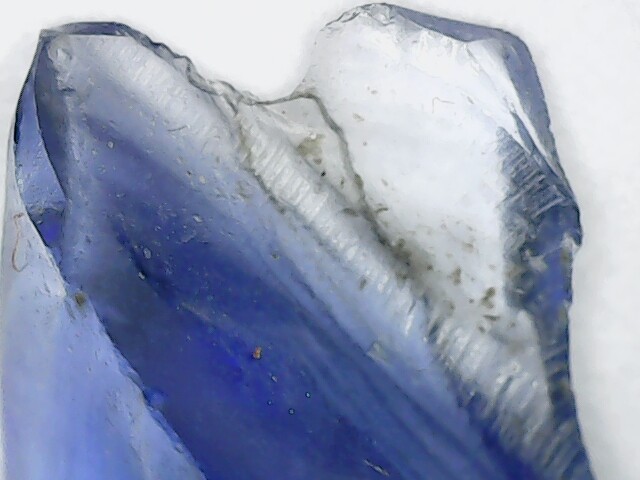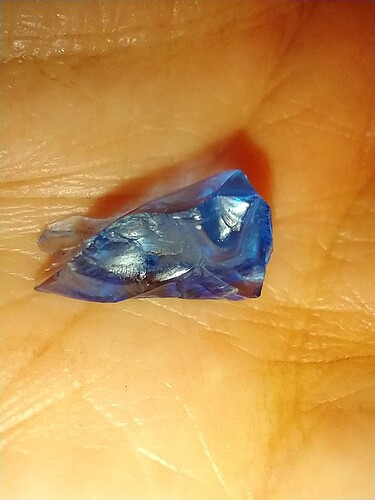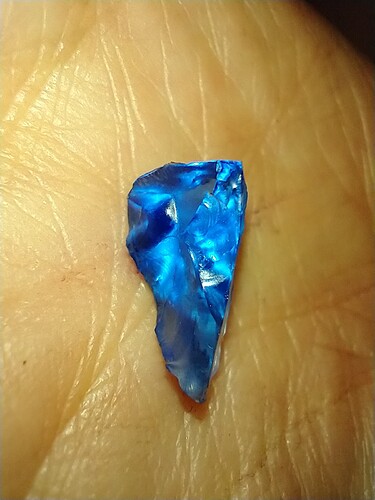IMG_20240108_061826673|375x500
Hello IGS community!
I found this beautiful crystal last year and I think it might be Hauyne. Specific gravity checks out at 2.48 but I would like to get a definite confirmation. It’s delicate and I want to go somewhere where it will be handled with the utmost of care. TIA for any suggestions in or near Denver Colorado.
Colorado School of Mines Museum curators might be able to identify it for free, or refer you to someone at the CSMT, geology for free… Check with the Denver gem and mineral guild… you have far more resources in Denver than in most places…
Just FYI: do you know were that stone came from? Hauyne is the calcic endmember is the sodalite family of minerals… it forms a solid solution with sodalite and nosean. Provenance and type locales are where silica unsaturated sodic and potassic igneous extrusive rocks are found… where it came from will also give you a clue. Unsaturated igneous rocks are not common nor widespread. Hauyne fracture is conchoidal as in your photo. SpG is 2.44- 2.48, Mohs hardness 5.5 -6… These physical properties however also apply to colored glass…Non destructive testing with optical techniques will work. Refractive index and absorption spectrophotometry should be able to identify it. Equipment to do this kind of testing should be available as they are not highly expensive machines…
Hi Steve,
Thank you so much for your thoughtful, informative reply, it is
much appreciated. School of Mines has a day (need to check which day, but think it might be once a month on a Saturday)
where you can bring rocks and the like that you need help identifying, thank you for reminding me of that excellent resource.
Regarding the potential Hauyne crystal. I was doing some digging near Clear Creek along the Front Range
here in Colorado when I spotted that blue beauty. Initially I assumed it was just a piece of blue colored glass,
but it is definitely a natural crystal and blue obsidian looks much different when I looked it up. I have found quite a bit of Iolite, Nephrite Jade, Nepheline, Porphyry and even a couple of
Lapis Lazuli stones in that same area that I have playfully titled, “Itz Minez”.
I’m really excited because of the rarity of this gemstone but trying not to get my hopes up. I really should sell it if it turns out to be Hauyne, but I’m madly in love
with it, so not sure I could even part with it, so my goal is to get lucky enough to find another one that way
I can sort of have my crystal and eat it too. ![]() I’m eager to hear your thoughts, now that you know the location of my find.
I’m eager to hear your thoughts, now that you know the location of my find.
I also found, in the same area, a light pink crystal that I’m wondering if it could possibly be Poudretteite, it has a SG of 2.51, but is that only found in Canada?
If not, I think Hauyne can also be pink, right? If you’re open to taking a look at it, I’ll send a couple of pics, I am writing this on my PC and the photos are on my
cell phone, so just let me know, although I get that photos are not the greatest way to authenticate gemstones.
I wish I could quit my day job and hunt rocks all the live long day!
Looking forward to hearing from you when you get a chance,
Thanks and Take Care,
Hinde AKA Chrysocolla
Hate to throw cold water on your enthusiasm:
If this specimen is from the clear creek or Idaho creek mining districts near Denver, I don’t think that the geology of that area supports any of the minerals that you have listed, with the possible exception of iolite. Hauyne as I have already mentioned is restricted to highly sodic and potassic unsaturated rocks. Those of the front range are ancient early Proterozoic (2.5 to 2.0 gA) granitic, biotitic gneisses and ultra metamorphic (migmatite) rocks… These rocks are uniformly silica saturated, with free quartz as a constituent of granites and granitoids… Unsaturated rocks and mafic to ultramafic ophiolite derived metamorphic rocks are not there, at least to my knowledge… porphyry is not a rock perse but describes a texture within an igneous rock…Lapis lazuli minerals, nepheline, are not present. Nephrite is an amphibole and is a mafic mineral of hi pressure low temperature metamorphism. The only area in the front range that has alkalic igneous rock is the phonolite volcano/diatreme of Cripple Creek which is much younger- oligocene. Gold mineralization in the form of polymetallic tellurides was being mined. Nepheline syenite is present along with porphyritic phonolite, later eruptions at the volcano included lamprophyres … the mining districts near where you are were mainly silver bearing lead-zinc ores, with some accessory copper and smaller quantities of gold in quartz. The only other alkalic affinity rock is the state line diamond bearing kimberlite pipes along the Colorado Wyoming border and non diamond bearing scattered kimberlites in the Estes Park to Boulder area of Devonian and earlier age.
I’m afraid that you have found a piece of old bottle glass. Many of the glass bottles during the western gold rush era were intensely colored and of the same shade and hue of your sample. If you can find an INTACT glass bottle of the same color you have a collector’s item on your hands, but not one of high value as so many were made during that time.
Colorado is a great state to study geology. The exposure of precambrian basement rock from the Laramide orogeny is superb. Crustal relaxation in the cretaceous lead to crustal spreading… the Sangre de Cristo mountains to the south were pushed up by the Rio Grande rift spreading zone while the area around Creede which produced silver was a large cretaceous volcanic field… almost all rock types exist in Colorado from diamond bearing kimberlites to mount Antero pegmatite gems…but the rocks you think you could have aren’t within the repertoire.
I still plan on getting it tested. Nature is wild and I haven’t shared the exact location
of my find. I will definitely let you know what comes of the testing.
would be interested to know… you’re lucky to have so many resources available in person in Denver. I would be very surprised if it is hauyne or any other
alkalic unsaturated mineral.
I agree with the “glass” suggestion. Old crown glass has a SG of 2.50… and perfect conchoidal fracture. I have seen Hauyne before and although it has a weak conchoidal fracture usually some of the surfaces will show a bit of a dodecahedral cleavage. Those pieces were associated with alkali eruptive lavas, which are not in the region indicated earlier. The refractive index would likely separate Hauyne from glass… the mineral is higher around 1.50… the glass is lower about 1.45.
Agree also that is glass…
Alkalic igneous rocks as previously mentioned exist only at the quaternary volcanic complex consisting mostly of phonolite and some ultrabasic alkalic lamprophyre of Cripple Creek. The only other exception to alkalic rocks in Colorado are the kimberlite pipes that are scattered from the Denver area north to the State Line kimberlites that are diamond bearing and are being currently mined for diamonds. Other kimberlites do not have diamonds. Kimberlites are of deep mantle origin and are not hauyne bearing. Kimberlite minerals include garnet, phlogopite mica, clinopyroxene, olivine, spinel… most are high pressure mineral phases associated with high pressure C02 and a deficiency in silica … secondary alteration with calcite is common…The isolated volcanic necks on the colorado plateau are ultrabasic with lamproite. minette and other associated potassic and undersaturated rocks… none contain hauyne… The kimberlites predate the Laramide orogeny. The Laramide orogeny exposed the granitic basement rocks of the front range and other rocky mountain ranges. The alkalic eruptions postdate the Laramide, as crustal relaxation and spreading started.
Glass has a range of refractive and SpG… lead glass, especially flint glass had a refractive index and SpG as high as 7… it’s no longer made due to lead toxicity. “normal” glass without lead has the refractive and SpG as stated… The intense blue color of 19th century glass came from cobalt salts.
The specimen displayed has a conchoidal fracture that is very marked… the fracture is so striking that there’s not much natural that has that kind of fracture except for obsidian which is a rhyolite glass. High silica flint would fracture that way also but would not have that color… I vote for man made glass.


Curious if twinning is possible in man-made glass?
Two pics of twinning in my potential hauyne crystal.
Twin planes are nice and sharp… not gradual over a distance. With the variation in color, the waves of color variation and the perfect conchoidal fractures… this is most likely “blue glass”
How does man-made glass form twins?
One of the ways to test hauyne for authenticity
involves putting nitric acid on the crystal and if it is hauyne needle-like crystals of gypsum should form (if they’re chlorite crystals it means it is sodalite). I was thinking this swallowtail-like formation would
be evidence for hauyne since that is often seen in gypsum twinning.
Natural Hauyne may fluoresce Orange under Long Wave UV excitation and Pink under Short Wave UV excitation. You can also rule it out as Hauyne if the specimen shows Doubly Refractive in the Polariscope (recall that Hauyne is Singly Refractive due to its Cubic crystal habit).
Glass doesn’t have a crystalline structure so it will not twin. what you have is an apparent fishtail twin which occurs in the monoclinic system. I think that it really is a “pseudo twin”… the surfaces show conchoidal fracture and the joint where the twinning is happening shows striations… it’s an artifact of fractured glass. Hauyne is cubic. Contact and interpenetration twins would not take on a fishtail habit… Hauyne belongs to the sodalite family of minerals and is rare, found in unsaturated volcanic and close to the surface plutonic rocks of silica undersaturated composition. Found as a constiuent of Lapis lazuli… afgan sources of lapis are metamorphic and occur at limestone contacts which desilicated the source rocks, also hydrothermal alteration in limestone contact skarns. Gem quality stone have long come from Germany source from unsaturated lavas. Vesuvius hosts ultra potassic rocks with hauyne and other unusual related foid minerals found in limestone blocks, digested by magma…I would be hesitant to reach any conclusion that a stone is Hauyne by color or appearance… it’s rare because the geological provenance is uncommon…
Can I ask where you found it? You need not get super specific, just general region. Thanks!
Chrysocolla01 first posted a cobalt bue stone that she/he said came from the Colorado front range. This looks similar. If it came from the front range it can’t be hauyne. Can’t be a twin hayne either as the twinning does not fit cubic twinning.
As I understand it, you live in the Denver metro area… I mentioned in a previous post on this thread that there are many resources for gem and mineral identification in Denver. Again, please avail yourself of these resources… the Colorado School of Mines Museum, the Denver Gem and mineral Guild…all you need to do is google the resources in Denver…There are many other resources available in Denver that can identify your stones. There is no substitute for in person expert testing and evaluation… pictures only tell a minimal story. Adding physical and optical properties narrows the range of possibilities down but still leaves room for only a range of possibilities…cannot definitively ID from pictures and SG, refractive index alone…
StevenH,
How’s your memory? Did you forget about your promise to not message me on this site? Clearly you have forgotten because now you have broken your promise and demonstrated that you’re no friend of integrity. My word is golden and I trust everyone until they give me a reason not to. You have already done that, broken your word, by insulting me and others on this site and disobeying a vow you yourself made to stop contacting me and only a few months ago at that, but you just couldn’t help yourself, could you? Please stay out of all the communication that involves me. I hope you are capable of respecting this boundary moving forward.
Chrysocolla AKA Hinde
I think that I may have forgotten… no so much you but someone else that I have contacted again. If so, then I will never contact you again. In the meantime, please continue with your self education and learn what others have to teach you… please do not get burned by people selling you stuff on Etsy… the diamonds exchanged for sapphires for $300 niether of which were real is a concern to all of us… we just don’t want you to get scammed. It’s all in good conscious. But you do have to learn from eveyone else too… how to avoid being taken by untrustworthy sellers. Take to heart when there’s a consensus and always be careful…
Hi there Paul! I believe this specimen was pulled from the ground about
15 miles SW of the Pike’s Peak area near Colorado Springs about 3-4 years ago.


